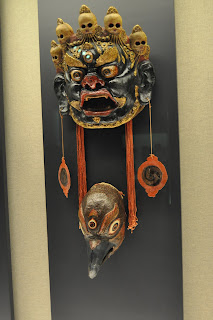After the Suzhou silk extravaganza, we headed to a decidedly different
area of Suzhou. The Master of the Nets garden has apparently been
considered one of the most beautiful of the many classical Suzhou
gardens, and the gardens as a whole have been named a UNESCO World
Heritage site, much like Gyeongju and Hwaseong Fortress I had visited in Korea three years prior.
illustrated map of the garden
Our guide, Mei, reenacting how the nobility of the garden would have sipped tea

Our next stop was Tongli, also known as the "Venice of the East" thanks to its many canals. Our group boarded several gondolas which meandered through Tongli's waterways amidst the atmospheric mist and drizzle.

Once we returned to dry land, we attempted to stop at the Retreat and Reflection Garden but unfortunately arrived just as they were closing. Instead of traversing through the garden, then, we spent some time browsing the shops and local goods in town.
Oddly enough, once in the shopping area, it seemed as though we had entered the Twilight Zone. Apparently there were only three types of stores- those selling the exact same silk products we had seen earlier that day in the silk factory, those selling scarves and trinkets, and those selling pigs' feet. Every three stores, this sequence would repeat until we felt an uncanny sense of deja vu.
one of the many pigs' feet vendors in Tongli
After traveling a few hours east back to Shanghai, we dined at a Chinese restaurant housed in a German building in the Japanese district of the city. As this was our final meal together as a group, we celebrated with complimentary wine, provided by the tour group.
Our guide Lucy toasting
For our final day in Shanghai, we caught up with the attractions on our itinerary we had missed during our unexpected layover in Wenzhou. First up was the Shanghai Museum in People's Square, said to have one of the largest collections in China. Despite this noteworthy fact, only the collection of minority clothing and masks really captured my attention. The majority of the museum was devoted to collections of ancient paraphernalia such as coins, seals, ceramics, and sculpture, which was no less important in the development of the Middle Kingdom, but decidedly less engaging for me on a personal level.
minority garb
Tibetan dream mask
a strange new addition to the collection
surprisingly lifelike sculpture
Following our jaunt through the Shanghai museum, our group trekked over to the famed Shanghai bazaar situated in the Old City region of town. Unfortunately, the bazaar was less of a bargainer's paradise and more of an overpriced swap meet, although we did find a spot offering reasonably priced sushi and noodles. We also happened upon a longtime Chinese tradition nestled in the heart of this historic neighborhood, a shop called Starbucks Coffee, which was perhaps the most happening spot at the bazaar.


After perusing the goods for sale, we were let loose into the streets of the city upon the sea to explore at our leisure. Our family decided to stop by the Shanghai Urban Planning Exhibition Center which, despite its propagand-ist sounding moniker, ended up proving to be one of the highlights of the city. Not only did the center house a historical exhibition on the changing architecture of Shanghai and particularly the Bund, it also boasted a miniature replica and virtual flythrough of the entire city. The exhibits displayed in the exhibition center highlighted the dramatic transformations Shanghai has undergone in the past century, as well as those it is currently undergoing in mass transit, industry, technology, and architecture. It wasn't until we explored the museum that I even began to comprehend the amount of manpower, brainpower, and foreign capital being poured into the city of Shanghai, and I couldn't help but wonder how dramatically different the city will be twenty years from now.
Haibao, mascot of the Shanghai 2010 World Expo, was more derivative of Gumby and less cleverly named than the Fuwa of the 2008 Olympics
miniature replica of Shanghai




















































